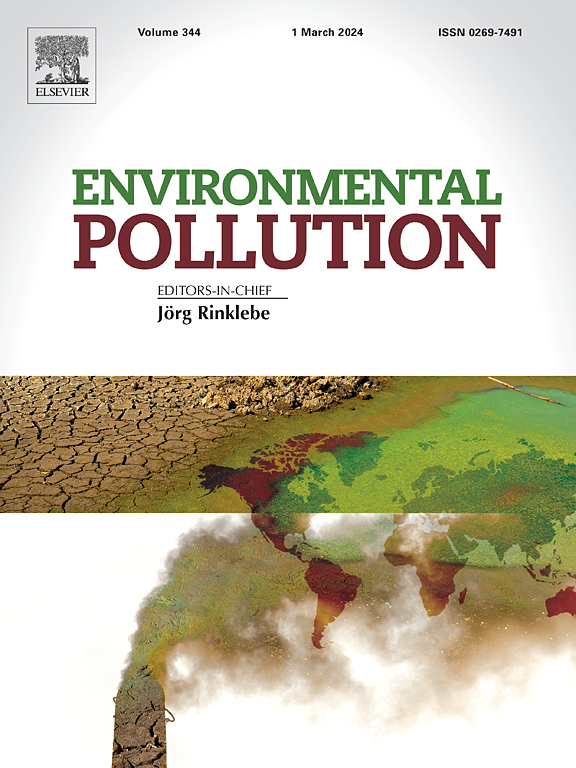Seasonal bioaccumulation and biomagnification of typical organochlorine pesticides in the Pearl River Estuary, South China
IF 7.6
2区 环境科学与生态学
Q1 ENVIRONMENTAL SCIENCES
引用次数: 0
Abstract
As a typical organochlorine pesticide, dichlorodiphenyltrichloroethane (DDT) and its metabolites (dichlorodiphenyldichloroethane (DDD), dichlorodiphenylmethane (DDM), dichlorodiphenyldichloroethylene (DDE), and bis(p-chlorophenyl)-chloroethylene (DDMU)) (collectively referred to as DDXs), have been widely detected in the Pearl River Estuary (PRE). However, seasonal variations in land runoff and the transformation of DDXs complicate their bioaccumulation characteristics in the PRE. The present study analyzed the sediment and aquatic organisms from both dry and wet seasons to investigate the seasonal characteristics of bioaccumulation of DDXs in the PRE. The median concentration of DDXs in sediments was significantly higher during the wet season (0.60 ng/g dw) than that in the dry season (0.25 ng/g dw), and the median concentration of DDXs in aquatic organisms was significantly higher during the dry season (518 ng/g lw) than that in the wet season (189 ng/g lw). Based on δ13C and δ15N values, the aquatic food web is composed of terrestrial and marine food chains. Using an improved trophic position (TP) quantification model (TPbulk-correction), significantly different correlation trends of DDXs in the food chain during the dry season were observed: along with the increasing of TPs, the abundance of DDT and DDM + DDMU decreased, while the abundance of DDD + DDE increased, which likely due to the DDX biotransformation. Additionally, this study found that elevated terrestrial nutrient input and the maternal-offspring transfer of DDXs could conceal the DDX bioaccumulation process during the wet season. Compared to the traditional TP quantification model (TPbulk), the TPbulk-correction model, which differentiates terrestrial from marine sources, can effectively reveal the significant correlation between the DDX composition and TPs. This emphasizes the need to integrate environmental conditions and biological processes for a comprehensive analysis of the biological behavior of pollutants.

珠江口典型有机氯农药的季节积累与生物放大效应
作为典型的有机氯农药,二氯二苯三氯乙烷(DDT)及其代谢物二氯二苯二氯乙烷(DDD)、二氯二苯甲烷(DDM)、二氯二苯二氯乙烯(DDE)和双(对氯苯)-氯乙烯(DDMU)(统称DDXs)在珠江口(PRE)广泛存在。然而,土地径流的季节变化和ddx的转化使其在PRE中的生物积累特征复杂化。本研究对干湿季节的沉积物和水生生物进行了分析,探讨了DDXs在PRE中生物积累的季节特征。沉积物中DDXs的中位数浓度在丰水期(0.60 ng/g dw)显著高于枯水期(0.25 ng/g dw),水生物中DDXs的中位数浓度在枯水期(518 ng/g lw)显著高于丰水期(189 ng/g lw)。根据δ13C和δ15N值,水生食物网由陆地和海洋食物链组成。利用改进的营养位置(TP)量化模型(tbulk -correction),观察到干旱季节食物链中DDX的相关趋势显著不同:随着TP的增加,DDT和DDM+DDMU的丰度降低,而DDD+DDE的丰度增加,这可能与DDX的生物转化有关。此外,本研究还发现,陆地养分输入的增加和DDX的母代-子代转移可能掩盖了DDX在雨季的生物积累过程。与传统的TP量化模型(TPbulk)相比,区分陆源和海洋源的TPbulk校正模型能够有效地揭示DDX组成与TP之间的显著相关性。这强调需要将环境条件和生物过程结合起来,以便全面分析污染物的生物行为。
本文章由计算机程序翻译,如有差异,请以英文原文为准。
求助全文
约1分钟内获得全文
求助全文
来源期刊

Environmental Pollution
环境科学-环境科学
CiteScore
16.00
自引率
6.70%
发文量
2082
审稿时长
2.9 months
期刊介绍:
Environmental Pollution is an international peer-reviewed journal that publishes high-quality research papers and review articles covering all aspects of environmental pollution and its impacts on ecosystems and human health.
Subject areas include, but are not limited to:
• Sources and occurrences of pollutants that are clearly defined and measured in environmental compartments, food and food-related items, and human bodies;
• Interlinks between contaminant exposure and biological, ecological, and human health effects, including those of climate change;
• Contaminants of emerging concerns (including but not limited to antibiotic resistant microorganisms or genes, microplastics/nanoplastics, electronic wastes, light, and noise) and/or their biological, ecological, or human health effects;
• Laboratory and field studies on the remediation/mitigation of environmental pollution via new techniques and with clear links to biological, ecological, or human health effects;
• Modeling of pollution processes, patterns, or trends that is of clear environmental and/or human health interest;
• New techniques that measure and examine environmental occurrences, transport, behavior, and effects of pollutants within the environment or the laboratory, provided that they can be clearly used to address problems within regional or global environmental compartments.
 求助内容:
求助内容: 应助结果提醒方式:
应助结果提醒方式:


